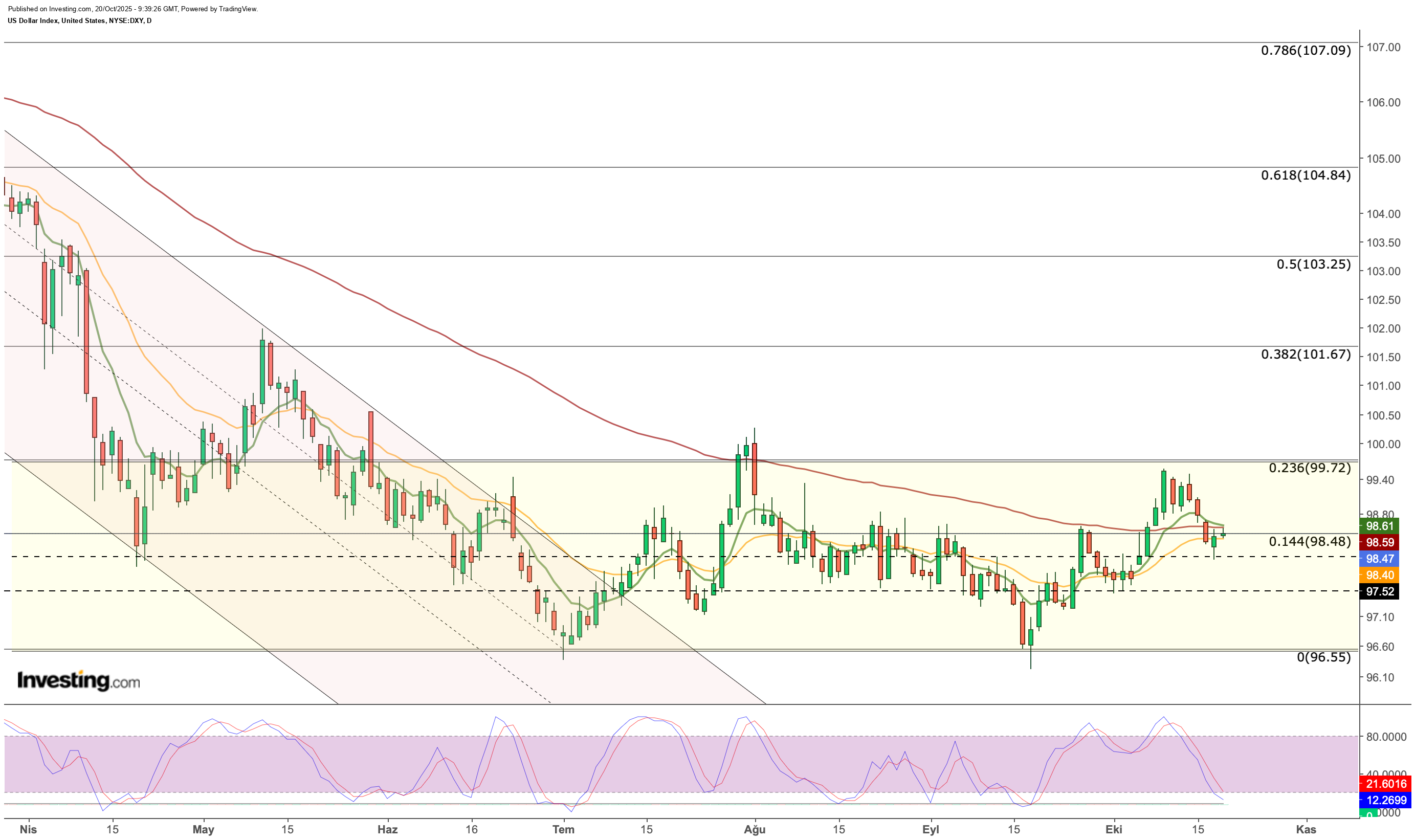
- The US dollar stabilizes as trade tensions ease and dovish Fed signals mount.
- Markets brace for inflation data, political uncertainty, and the ongoing government shutdown.
- DXY remains under pressure, with technicals pointing to a fragile near-term outlook.
- Looking for actionable trade ideas to navigate the current market volatility? Subscribe here to unlock access to InvestingPro’s AI-selected stock winners.
The started the week stabilizing at 98.5 levels as trade tensions between the US and China eased. US President Donald Trump’s statement that retaliatory tariffs against China are “unsustainable” led to a significant recovery in global risk appetite.
Investors expect this week’s talks between US Treasury Secretary Scott Bessent and Chinese Vice Premier He Lifeng to further ease tensions ahead of the Trump-Shi summit, expected to take place at the end of the month. This weakens safe-haven demand and limits the dollar’s global appreciation momentum.
While the easing of trade tensions has led to a partial improvement in global growth expectations, investors have turned their attention back to US domestic dynamics. Disruptions in data flow—especially due to the government shutdown—continue to be a source of uncertainty for the dollar index. The cessation of activity in some public institutions delays the release schedule of economic indicators, which brings cautious pricing in the markets.
Inflation Data on Markets’ Agenda: Fed’s Roadmap Clarifies
On the other hand, the most critical agenda item this week will be the September data to be released on Friday. Headline inflation is expected to rise to 3.1%, while is expected to remain unchanged at 3.1%. Data in line with expectations may strengthen the Fed’s “no problem” perception and legitimize the rate cut process. Indeed, markets are almost certain that the Fed will cut interest rates by 25 basis points next week. Another rate cut in December and the possibility of three additional rate cuts throughout 2026 are also included in the pricing.
On the Fed front, the dovish tone is becoming more pronounced. In his speech last week, Chairman Jerome Powell drew attention to the weak labor market and emphasized that the end of the balance sheet reduction process is near. While this rhetoric supports the Fed’s tendency to loosen financial conditions, it puts pressure on the dollar index. New Fed Governor Stephen Miran’s statement that “a 50 basis point cut is necessary, but it is likely to be limited to 25 basis points” was also perceived in the same direction. These statements support the downward pressure on the US dollar, while the decline in US bond yields limits the upside potential of the DXY.
Geopolitical Developments Shape Risk Perception
Developments affecting the markets on the geopolitical front are also being closely monitored. Trump’s planned meeting with Russian President Vladimir Putin and his cautious stance on arms aid to Ukraine stand out as determining factors in global risk perception. Trump’s statement that he strongly advised Zelenskiy to end the war increased hope for a diplomatic solution in the markets. This development is among the factors that may support risk appetite and affect dollar demand.
On the other hand, the third week of the government shutdown in the US is putting pressure on economic activity by leading to cuts in public spending and staff reductions in some institutions. This creates a contradictory picture for the dollar index: in the short term, demand for the dollar increases due to uncertainty, while in the medium term, expectations of economic weakness strengthen the possibility of dollar depreciation.
The general outlook for the markets is that the dollar will continue to weaken globally as the Fed’s cycle approaches and tensions between the US and China ease. In this environment, the dollar index stabilized around 98.5, while the recovery in risk appetite supports major currencies such as the euro, sterling, and yen.
DXY Technical Outlook
The dollar index continues its channel movement in the 96–99 band according to the technical outlook. DXY, which found support at the 98 level during last week’s retreat, started the week by testing the 98.5 resistance. Depending on the developments during the week, if the index exceeds 98.5, it may move toward the upper limit of the channel, which we follow as 99.7 on average.
 If the moderate global economic outlook continues, the pressure on the DXY may persist due to the increase in risk appetite. In this case, we may see the index retest the 98 level and, in case of a break, fall to 97.5, which is intermediate support.
If the moderate global economic outlook continues, the pressure on the DXY may persist due to the increase in risk appetite. In this case, we may see the index retest the 98 level and, in case of a break, fall to 97.5, which is intermediate support.
To summarize, the dollar index will be shaped by both US domestic political developments and trade talks this week. If the Fed’s dovish messages and expectations for trade peace are maintained, the downward pressure on the index is likely to continue. However, should inflation data beat forecasts, this short-term equilibrium could be disrupted, and the DXY could move back toward the upper boundary of the channel.
****
InvestingPro provides a comprehensive suite of tools designed to help investors make informed decisions in any market environment. These include:
- AI-managed stock market strategies re-evaluated monthly.
- 10 years of historical financial data for thousands of global stocks.
- A database of investor, billionaire, and hedge fund positions.
- And many other tools that help tens of thousands of investors outperform the market every day!
Not a Pro member yet? Check out our plans here.
Disclaimer: This article is written for informational purposes only. It is not intended to encourage the purchase of assets in any way, nor does it constitute a solicitation, offer, recommendation or suggestion to invest. I would like to remind you that all assets are evaluated from multiple perspectives and are highly risky, so any investment decision and the associated risk belongs to the investor. We also do not provide any investment advisory services.
